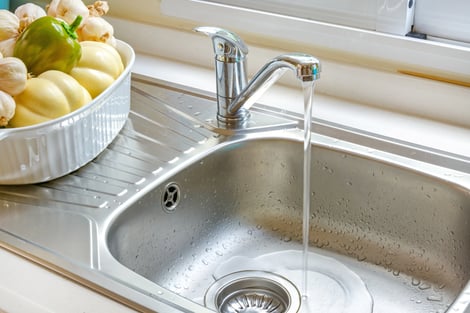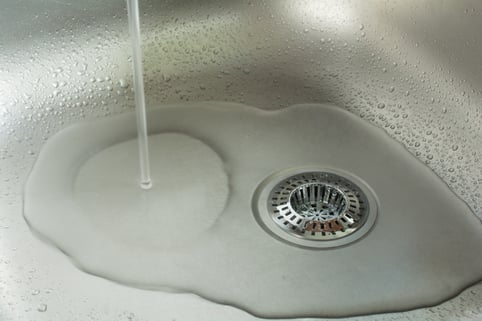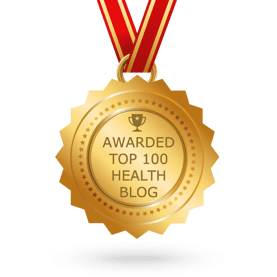Edited: November 11, 2021
It depends.
If you use tap water, you can find out relatively easily by perusing the website of your local water utility. Local water utility websites (District of Columbia Water and Sewer Authority, and Washington Suburban Sanitation Commission, for example) and EPA.gov contain a wealth of information on regulated contaminants, like lead and coli-form bacteria (like E. Coli), and on currently unregulated (but periodically tested for) contaminants, like chromium 6 (entered into popular culture by the movie Erin Brockovich) and strontium.
If you use well water, testing every few years by a laboratory certified to do so should disclose the contents of the water, the results of which are subject to activity or industry near your property, above or underground.
What does this have to do with your health?
Your Body on Toxins
Toxicologically speaking, humans can be thought of as a sink with a faucet and a drain:

Water flowing into the sink represents everything your body has no use for, or needs to get rid of because an accumulation would be detrimental – in short, incoming water is anything that could be considered a toxin.

Turn the faucet on full blast and your sink could conceivably overflow relatively quickly, like the one above, especially if the drain is blocked even minimally. Or perhaps the drain is completely open; maybe it's even a bit larger than other drains, like in the graphic below. Water may then flow out more quickly than it flows in, even if the faucet's blasting. No overflow. People with "large drains" are the ones whose genetics favor detoxification.

On the other hand, your faucet may be dripping slowly, but the drain is completely blocked. It will take awhile, but eventually the sink will overflow. Throw a brick into an almost-full sink and it will overflow all at once.
The fully open faucet is akin to a hazardous exposure to a toxin over time. For example, daily exposure to greater than permissible amounts of the silica dust that killed one worker who cut granite at a Texas furniture factory in 2014. Another example might be the lead exposure to a developing fetus whose mother regularly drank the Flint water during the height of the lead contamination crisis.
It's important to keep in mind that no one is ever exposed solely to just one toxin. Each of these cases is oversimplified, but in reality, individuals are exposed to the toxic soup to which we all find ourselves more or less captive: chemicals and radiation in our water, air, food, soil, dust and non-food consumer products.
Toxin Exposure from Daily Living
More pertinent to the average person under normal circumstances (not a public health crisis) is the leaky faucet analogy.
Pesticides *Drip*
Heavy metals *Drip*
Phthalates in my take out *Drip*
And so on.
The ability to rid the body of environmental contaminants through detox (including excretion mechanisms) is represented by the drain. The adequacy of the drain is determined by a number of characteristics, such as genetics, nutritional status, lifestyle and the toxic load itself, which includes pervasive stress. We now know that all of these (not your genes, but the expression of your genes) can be modified.
Check out the resources at Environmental Working Group. Enter your zip code into their Tap Water Database and find out which contaminants were identified in the water supply to your area. Once you do, you can access the "Filter Contaminants Out" button so you know how to address any problems.
 Dr. Dawn Cannon, MD, MS, is an integrative physician at National Integrative Health Associates, serving the metropolitan Washington, D.C. area. Her focus is Integrative medicine: adult primary care and preventive medicine, approached holistically. Her special interests include detoxification for the damaging effects of environmental exposures and toxins, women's health, and a functional medicine approach to finding the root cause of disease.
Dr. Dawn Cannon, MD, MS, is an integrative physician at National Integrative Health Associates, serving the metropolitan Washington, D.C. area. Her focus is Integrative medicine: adult primary care and preventive medicine, approached holistically. Her special interests include detoxification for the damaging effects of environmental exposures and toxins, women's health, and a functional medicine approach to finding the root cause of disease.
References
1 Edwards M, Falkinham J, Pruden A. Synergistic impacts of corrosive water and interrupted corrosion control on chemical/microbiological water quality: Flint, MI. National Science Foundation Grant abstract. Available at http://www.nsf.gov/awardsearch/showAward?AWD_ID=1556258&HistoricalAwards=false Accessed February 7, 2016.
2 City of Flint 2014 Annual Water Quality Report. 2014. Available at: https://www.cityofflint.com/wp-content/uploads/CCR-2014.pdf Accessed February 7, 2016.
3 Lynch, J. Michigan officials warned of water, Legionnaires’ link. The Detroit News. Available at: http://www.detroitnews.com/story/news/michigan/flint-water-crisis/2016/02/04/flint-water-crisis-legionnaires/79828822/ Accessed February 7, 2016.
4 See http://www.epa.gov/dwlabcert/contact-information-certification-programs-and-certified-laboratories-drinking-water Accessed February 7, 2016.
5 2014 Preventable Deaths: The Tragedy of Workplace Fatalities. A Report Presented by the National Council for Occupational Safety and Health (COSH) . Accessed February 7, 2016.
6 Hu H, Téllez-Rojo M, Bellinger D, et al. Fetal lead exposure at each stage of pregnancy as a predictor of infant mental development. Environmental Health Perspectives. 2006;114:1730–1735.
7 Also known as plasticizers, found in adhesives, automotive, plastics, detergents, lubricating oils, some medical devices and pharmaceuticals, plastic raincoats, solvents, vinyl tiles and flooring, personal care products, toys and other items.
Sink Photo credit: http://www.startribune.com/how-to-inspect-your-own-house-part-6-plumbing/278984421/
Other references and resources
Hanna-Attisha, M, LaChance, J, Sadler, R, Champney Schnepp, A . Elevated Blood Lead Levels in Children Associated With the Flint Drinking Water Crisis: A Spatial Analysis of Risk and Public Health Response. American Journal of Public Health 106 (2): 283–290.
For helpful information on drinking water, testing, contaminants, etc., go to http://www.drinktap.org/
.png?width=305&height=132&name=NIHAlogoBLUE_3_transparent%20(2).png)

